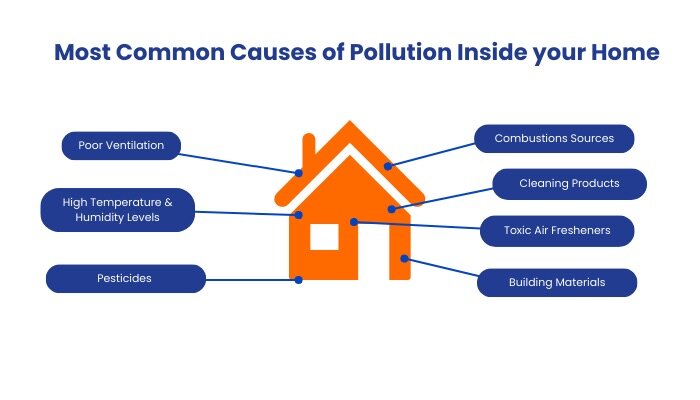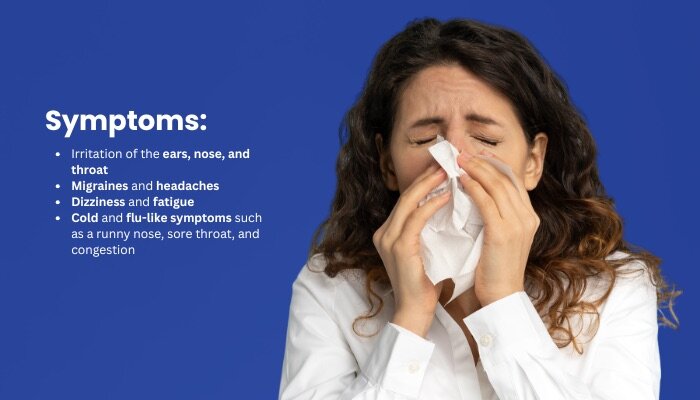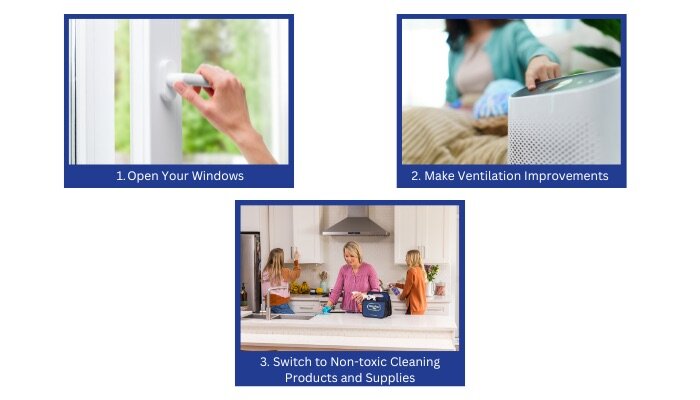- Shop
- Learn

Posted By: Truly Free Home
|
Posted On: 6/1/2023
Outdoor air pollution may make the headlines, but indoor air quality is just as important for your family’s health.
That’s because on average, we spend about 90% of our time indoors, according to the EPA.
If you or your family have headaches, runny noses, or always feel tired, it’s probably time to look more closely at your home’s indoor air quality.
Indoor air quality is affected by everything from how often you open your windows to what cleaning products you use in your home.
Two things to keep in mind when it comes to air quality in your home:
Here are the most common causes of pollution inside your home.
Poor ventilation can decrease indoor air quality by not bringing in enough outdoor air or not carrying out enough indoor air pollutants.
High temperature and humidity levels can increase concentrations of some indoor air pollutants like dust mites, mold spores, bacteria, and other allergens.
Combustion sources: When wood, gas, or tobacco burn, they produce gases like carbon monoxide, nitrogen dioxide, and fine particulate matter which can be harmful when inhaled at elevated levels.
Building materials like paint, paint strippers, and pressed wood products can release pollutants into the air. Plywood, particle board, and paneling can release formaldehyde.
Pesticides used to kill, repel, or control pests may release hazardous air pollutants (HAPs) and volatile organic compounds (VOC).
Cleaning products made with dangerous chemicals such as ammonia, chlorine, bleach, triclosan, and sodium hydroxide can release air pollutants.
Toxic Air fresheners made with chemicals that are either probable human carcinogens or VOCs associated with cancer such as toluene, ethylbenzene, or xylenes.

Indoor air pollution can significantly impact your health, often causing symptoms that mimic common illnesses like colds or the flu.
Common symptoms include:

Signs you’ve got issues with your indoor air quality include:
Signs you’ve got issues with your indoor air quality include:

1. Open your windows
If you suspect your home’s air quality is poor, the first thing you should do is regularly open the windows for fresher air.
Opening the windows for refreshening the air in your home daily is a good habit to practice, especially as the weather turns cooler. Proper ventilation and adequate air exchange are vital to a healthy indoor environment.
In Germany, residents open their windows twice a day— even in the cold winter months. Those living in rental properties are required to open their windows as this practice is scientifically proven to prevent mold growth.
2. Make ventilation improvements
These days, air conditioners are pretty standard in American homes. But Air Purifiers? Not so much!
Investing in an air purifier to improve indoor air quality can set you back financially, but some models are capable of filtering the air to 100% purity, making them well worth the money for those who need to prioritize their health.
If undertaking such an expense is not in your budget, consider calling your local HVAC experts to clean your air vents. Don’t be afraid to ask them any questions about additional maintenance, like changing the air filter.
3. Switch to non-toxic cleaning products and supplies
Aside from opening your windows, the fastest way to make your home safer is to swap any traditional cleaning products for toxic-free cleaning products that are free of harsh chemicals and made with more natural ingredients.
It’s no secret that a clean home = a healthy home. But the truth is that the toxic cleaning supplies and products marketed to you over the years are actually highly toxic.
Everything cleaning products sprayed and wiped around your home images its way into your body both through the air via your lungs and direct contact via skin absorption.
To avoid feeling overwhelmed, start replacing one cleaning product at a time with a toxic-free cleaning product, like toxic air fresheners.
Toxic room ‘deodorizing’ sprays are chemically engineered to shut off your sense of smell. Getting rid of those and replacing them with non-toxic air fresheners like Truly Free Home’s scented Space Freshener or Unscented Odor Eliminator is a great place to start.
To keep your family and loved ones safe, keeping the air in your home pure and clean is paramount. Luckily, small changes, like switching to a non-toxic air freshener or room deodorizer, will make a big impact.

Truly Free Home is a non-toxic home cleaning and laundry product brand on a mission to free over 10 million homes from harmful toxic chemicals and excessive plastic waste.